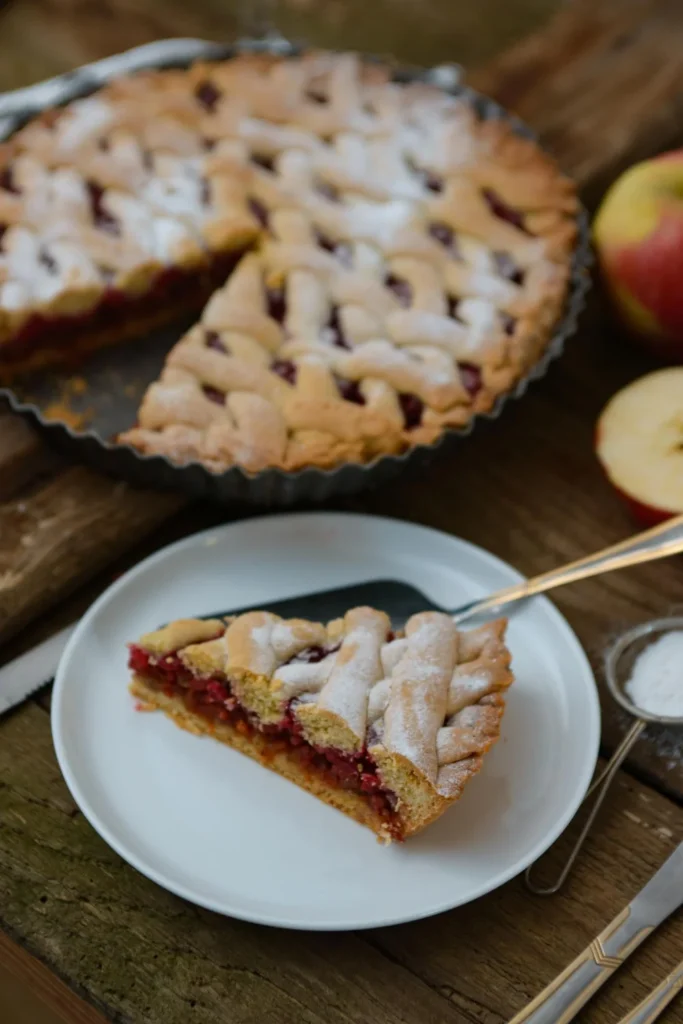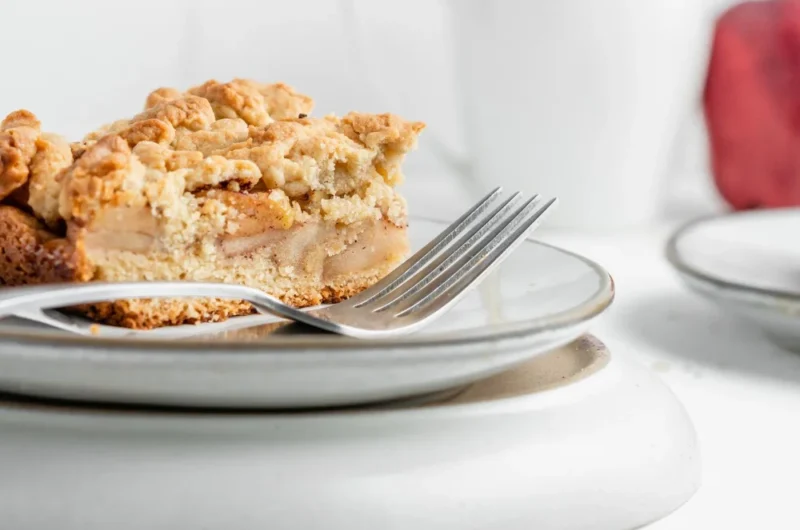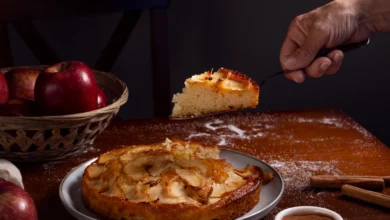Apple and White Chocolate Scones: Guide to Sweet Treat Recipe

As an avid baker who loves experimenting in the kitchen, I am always on the lookout for new scones recipes to try. In a recent search, I came across a recipe for Apple and White Chocolate Scones that sounded absolutely divine. As a self-proclaimed believer that fresh baked goods are one of life’s simple pleasures, I knew I had to give this recipe a try.
No recipe is perfect right out of the gate, so I decided to make a few modifications based on lessons learned from previous baking expert endeavors. Recalling tips from my mother on how to achieve light and flaky scones, I opted to grate the apple rather than chopping to avoid excess moisture. I also chose to freeze the butter before cutting it into the dry ingredients to ensure large pockets of tender goodness rather than a dense texture. After some testing, I found the best way to incorporate the white chocolate chips was to gently fold them in at the end rather than stirring to maintain their integrity.


Contents
- Apple and White Chocolate Scones
- Apple and White Chocolate Scones
- IngredientsFor the Scones
- Directions
- Notes
- FAQs
- Why are my scones not fluffy?
- How can I make my fruit scones rise and become fluffy?
- Are scones hard or soft?
- Is A scone a cake or a biscuit?
- Which flour is best for scones?
- How thick should scone dough be?
- Why is baking powder used in scones?
- Can Scones Be Made Ahead Of Time?
- Can You Freeze Scones?
- Is a scone healthy?
Apple and White Chocolate Scones
The scones emerged from the oven absolutely melting in my mouth with each bite. The subtle sweetness from the apples and chocolate combined for a delightful natural treat. Baking never fails to brighten my day and sharing with friends brought us all a moment of simple joy. Perhaps these lessons will inspire you to explore your own creations in the kitchen and discover new flavors that become fast favorites.
What are Scones?
Scones have a long history in the United Kingdom as a classic traditional baked good often enjoyed during an afternoon cream tea. The origins of a scone are traced back to the British baked fruit bread known as a ‘frumenty cake’. Over time, the scone evolved into its own category of a lightly sweet, rich flaky, and tender quick bread.
A classic scone takes on either a disc-like or cylinder like shaped form, sometimes described as curved. Texturally, a properly baked scone should have a fluffy and not dense interior with a nicely browned exterior. In the UK, scones are generally split then slathered with clotted cream and jam though their popularity has allowed various shapes, sizes, and flavours as they have travelled around the world. Compared to their American counterparts, British scones tend to have a richer ingredient composition due to the presence of cream, eggs and higher fat content. Some variations may also include the addition of fillings.
What Do Scones Taste Like?
While a traditional plain scone has a subtly buttery and lightly sweet profile due to modest sugars and creams, their beauty lies in easy customization. Even simple additions like dried fruits, nuts or spices impart distinctive new flavour options.
A well-executed scone balances texture perfection, with an interior that is soft and tender yet able to support generous pats of accompaniments. On the outside, the ideally baked scone is encased in a thin, crisp, and flaky crust that lends valuable crunch to each bite. The exterior colour should be a pale golden brown to achieve the textural magic within.
Taking that first bite of a piping hot scone stacked with cream and preserves is a moment of heavenly revelry. The layers of taste and sensation represent the finest qualities of simple indulgence and delight. With scone passion, the endless customization provides lifelong discovery of new flavour tanginess.
What is the Secret to Moist Scones?
The key to achieving light and moist scones with a deliciously crumbly texture lies in handling the dough as little as possible. Many novice bakers make the mistake of over-working or over-spreading the scone dough, causing it to become tough.
Using cold ingredients like frozen butter, heavy cream, and egg helps ensure the fats remain incorporated into pea-sized pieces rather than blending into the surrounding dough. This leads to partitioned pockets of richness throughout that create layers of flaky separation when baked.
Gently folding wet ingredients into the dry mixture by hand is preferable to kneading. Over-mixing can develop the gluten structure too much, resulting in a dense brick-like texture rather than a tender crumb.
Another trick is to use the lightest touch possible when patting the dough into shape on the baking sheet. Excessive spreading distorts the layers, preventing the flaky expansion desired in the oven’s heat. Patience and a light hand prevent disaster!
When baked properly, the cold fat particles amongst the floured ingredients meld into a deliciously moist and crumbly structure that makes for the perfect scone enjoyment.
RELATED: Soft Apple and Salted Caramel Cookies
What to Avoid When Making Scones?
- Forgetting to use cold ingredients like butter, eggs and cream. This is key for achieving the flakiest texture.
- Overmixing the dough. The gluten in all-purpose flour can become elastic and tough if mixed too vigorously.
- Not chilling the raw dough. A brief rest in the fridge helps relax the gluten further before baking.
- Baking ahead of time. Scones are best enjoyed fresh from the oven while their crumbly layers are still distinct.
- Overworking the dough when shaping. A light touch prevents the fat particles from being distorted during forming.
Why are Scones Light and Crumbly?
Absence of a gluten network
In contrast to breads where developing gluten is important for structure, scones are not kneaded or given long periods of time to rest. This allows the proteins in the flour, namely gluten, to remain in their natural state of shorter strands that are unable to form a cohesive, stretchy, and flexible gluten network seen in the final loaf. Without this cumulative development, scones are free to flake apart easily into chunks that will not tear or pull into a stretchy mass like a baguette. The absence of gluten strengthening over time leaves scones prone to portioning into delicate layers.
Pockets of fat
Another important factor that promotes flaky goodness in scones is the presence of pockets of fat throughout the dough. These fats acts as barriers that prevent the proteins and starches in the flour from forming a solid structure during baking. Instead, they dissolve and rupture during the bake, creating natural separation points where the scone is easiest to break apart layer by layer.
Air bubbles create lightness
The final crucial ingredient that allows scones their trademark height and texture are leavening agents like baking powder and baking soda. When mixed with the liquid components and exposed to heat in the oven, these reactants produce carbon dioxide gas. The puffs of gas inflate the dough as it bakes, but the lower amount of liquid and stickier dough holds its shape better than a moister, stiff bread. Finding the ideal balance is key to ensure scones rise to an airy lightness without becoming dry.
Apple and White Chocolate Scones
Course: Cakes and DessertsCuisine: British cuisine15
minutes15
minutes150
kcal8 scones
30
minutesHere is the recipe ingredients, and instructions. You can also print the recipe for your ease.
Ingredients
For the Scones
2 cups all-purpose (AP) flour
3 tablespoons brown sugar
2 tablespoons white sugar
1 teaspoon white sugar for sprinkling on scone
1 teaspoons baking powder
1⁄4 teaspoons baking soda
1⁄2 teaspoons salt
1⁄2 cup unsalted butter frozen
1⁄2 cup sour cream
1 egg large
1 cup Gala apple diced (1 apple)
1⁄2 cup white chocolate chips
- For the Optional Salted Caramel drizzle (adapted from Sally’s Baking Addiction)
3 tablespoons unsalted butter
1⁄2 cup white sugar
1⁄4 cup heavy cream
1⁄2 teaspoons salt
Directions
- Preheat oven to 400 °F and place an oven rack in the middle position. In a large bowl, whisk together the flour, brown sugar, white sugars, baking powder, baking soda and salt.
- Grate the frozen butter over the dry ingredients and mix with a fork until mixture resembles a coarse meal. Stir in the diced apple and white chocolate chips.
- In a separate bowl, whisk together the sour cream and egg until smooth. Create a depression in the middle of the dry mixture and add the wet ingredients into it.
- Gently fold the wet into the dry using a spatula until just combined. Turn out onto a lightly floured surface and knead gently 5-6 times.
- Pat dough into a 1⁄2-inch thickness and cut rounds using a biscuit cutter or knife. Gather scraps and reroll once to cut more scones.
- Place scones 1 inch apart on a parchment lined baking sheet. Brush the tops with remaining sugar.
- Bake for 15-17 minutes until golden brown. Let it cool down on a wire rack.
- Make optional salted caramel sauce by heating butter and sugar in a pot over medium-high heat. Once sugar dissolves lower heat and stir until smooth and caramelized. Remove from heat and whisk in cream. Cool before serving.
- Drizzle salted caramel sauce over cooled scones. Enjoy pairs with afternoon tea!
Notes
- Be gentle when shaping the dough to prevent overworking, which could result in a dense texture rather than the desired light and tender crumb.
- For best results, follow the tip to use chilled butter, sour cream and eggs to maintain flakes of fat that create separation between the layers as it bakes.
- The option to make the salted caramel sauce takes these scones from good to truly indulgent! Be sure to use a light hand when drizzling to enjoy the balance of flavors.
- As mentioned, the secret is avoiding overmixing which can strengthen the gluten structure too much. A brief mixing just until combined is all that’s needed.
- Feel free to experiment with different fruits, chips or drizzles to customize but be sure not to overload the dough which may cause it to become dense rather than light and fluffy.
Conclusion
This scone recipe showcases what makes these treats so enjoyable – the balance of tender richness within and flaky layers without. Following the techniques ensures pockets of fat create an irresistibly crumbly texture. Baking brings the scones to an airy lightness, complemented beautifully by additions of apple and white chocolate. Most importantly, the final outcome will be a warmly welcomed indulgence best shared with family or friends.
FAQs
Why are my scones not fluffy?
Common reasons could be using expired leavening agents, not properly preheating the baking tray, or ingredients of low quality.
How can I make my fruit scones rise and become fluffy?
Bake them at a higher temperature until tall and risen. Ensure the baking powder is fresh and reacts well to the burst of heat. Space scones slightly apart so they can rise evenly without touching.
Are scones hard or soft?
Traditionally scones should be soft and crumbly inside like shortbread, not hard like a biscuit or dry like hard bread. Opinions vary though – chefs are often coy about scone secrets!
Is A scone a cake or a biscuit?
In the U.S. it’s considered a biscuit but in the U.K. it’s more like a lightly-sweetened quick bread cooked together in a rounded or triangular shape. Scones can be either sweet like a cake or savory.
Which flour is best for scones?
All-purpose flour is most common as it allows scones to rise properly while retaining a light texture. Cake flour makes them too delicate and lower-protein flours risk being dense.
How thick should scone dough be?
The dough should be flattened to 1-2 cm thickness (~1/2-3/4 inch). Any thicker may prevent fully cooking inside, while too thin could make rolling or cutting difficult.
Why is baking powder used in scones?
Baking powder provides lift and raises the scones through releasing carbon dioxide gas when mixed with liquids and heated in the oven. It’s a convenient leavening agent.
Can Scones Be Made Ahead Of Time?
Yes, the dough can be shaped, placed on a tray and refrigerated overnight then baked the next morning.
Can You Freeze Scones?
Yes, you can freeze unbaked scones for up to a month. Shape, wrap tightly and bake directly from frozen, adding a few extra minutes to the cook time.
Is a scone healthy?
Not especially. While many recipes vary, on average a scone provides around 400 calories depending on ingredients and additions like sugar, butter/cream etc. But enjoyed in moderation, scones can be incorporated into a well-balanced diet.





